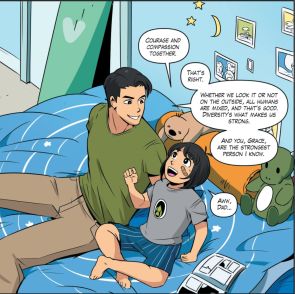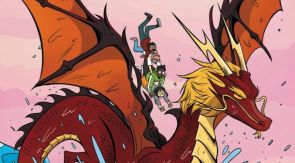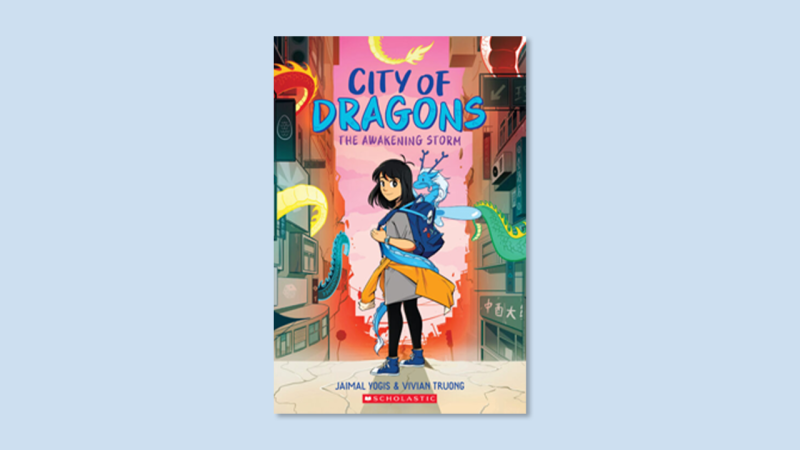
In Scholastic’s City of Dragons, author Jaimal Yogis and illustrator Vivian Truong ask us to consider what it would be like if the fantasy stories we grew up hearing were true. When Grace is bullied for being biracial, her father brings up a story her ye-ye used to tell. “You’re really going ancient China on me, Dad?” she asks, not yet realizing the tale is far more relevant than she can imagine.
The Yellow Emperor, the story goes, beloved father of the Chinese people, could transform into a powerful and fearless dragon. With his kingdom under attack, he shared a drop of his immortal blood with his fiercest warriors, who became stronger than the gods with the courage of immortals and an even greater sense of compassion. Even so, common people called them half-breeds and lizard men, jealous of their strength and their relationship to dragons. Ye-ye’s story ultimately succeeds in comforting Grace, illustrating the power of having a multicultural identity while making her feel connected to her Chinese heritage.
“I imagine Grace, like a lot of kids, felt a little isolated, growing up in the U.S. and feeling disconnected from her ancestors and particularly her Chinese half,” said Jaimal. Grace’s grandfather’s tale anchors her to her cultural roots, and by extension to her own personal strength, and she’ll come back to it for guidance throughout her journey.
Throughout the graphic novel, Jaimal and Vivian weave together history, ancient folklore, and current events to tell a new story that reimagines dragons for our modern world while paying respect to the legends of the past. They draw mainly from Chinese mythology, in which dragons are benevolent, though they are important across cultures and geographies, sometimes representing different things.
“On one side, dragons are ferocious monsters, and on the other side, they’re a symbol of good luck,” said Vivian. “They are protectors and guides, symbols of power and ferocity, and they are elemental, strongly associated with nature.” Their universal significance has the power to connect us, and placing them in modern-day Hong Kong, rather than a far-off fantasy world, shows readers just how much we can still learn from them. Their stories and their strength may be just what we need to understand and navigate today’s challenges.
For Grace, dragons help her understand her roots, her extraordinary lineage, and what that means for her place and responsibility in her world. At first, she is insecure, not quite sure where she belongs and what her destiny is. To tell her story, Vivian drew from her personal experience as a child of immigrants born in London. “Half of my world was trying to immerse myself in the Chinese world but the other was hiding it because people didn’t understand it. When I grew up, I became more confident in embracing my Chinese side and my British side as well,” she said, noting that she reflected parts of herself in her depiction of Grace.
Similarly, Grace begins to connect with her heritage and look more deeply at the stories passed down through her family. As the story progresses, a compelling stranger gives her a mysterious egg that later releases a water dragon. It’s a familiar figure from Chinese mythology, but this one is updated for his new setting. “Because Grace is half-Chinese and half-American, I wanted him to look both as well. His wings are the American ideal, and he has the serpent body of dragons in Chinese culture,” Vivian said. He’s also electric blue and named Nate, after Grace’s father.
Nate’s unexpected presence puts Grace in the position of having to look to her history to figure out what’s happening and what she’s meant to do. “Grace comes to understand her ancestry very viscerally through a dragon. It’s very much a story about stepping into who you are and your culture, and that is also metaphorical for any kid coming of age, understanding who you are deep down. By understanding history, Grace can step into her full courageous self,” Jaimal said.
And she does. While trying to find out more about Nate and the special connection she feels with him, Grace and her friends come face-to-face with a dangerous evil force. To defeat it, they each have to tap into their unique backgrounds and skills, with help from ye-ye’s story, a wise elder, and, of course, Nate.
The image of the water dragon, and some other mythical friends, against the landscape of contemporary Hong Kong embodies Vivian and Jaimal’s new mythology, built on long-lasting symbols of the past and reinterpreted to help Grace, and readers, make sense of what’s now and what’s ahead. The story is applicable to all of us, even if we don’t see the dragons around us. Or maybe we should look more closely. “You don’t see dragons, but you can see their forms in clouds and the sea. I like the idea that they are still lurking, and if you look hard enough you might see them,” Vivian said.



